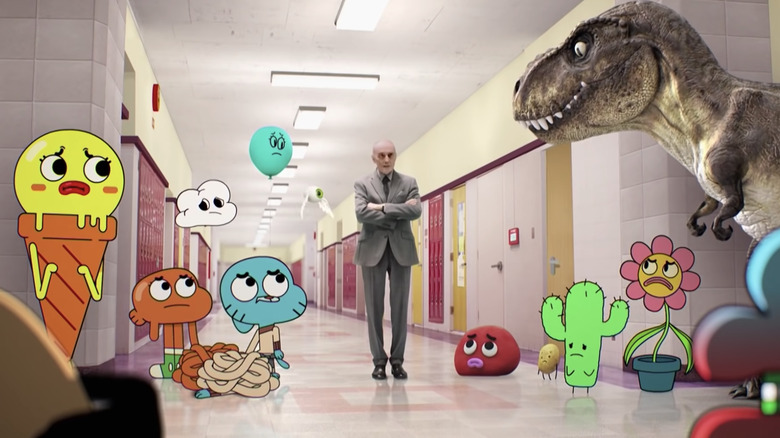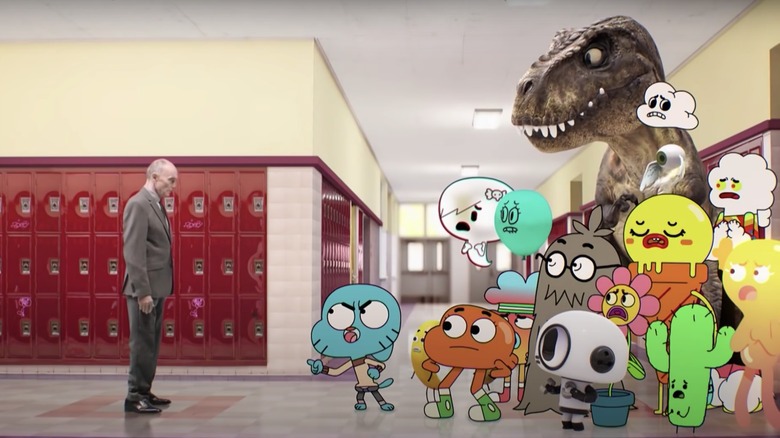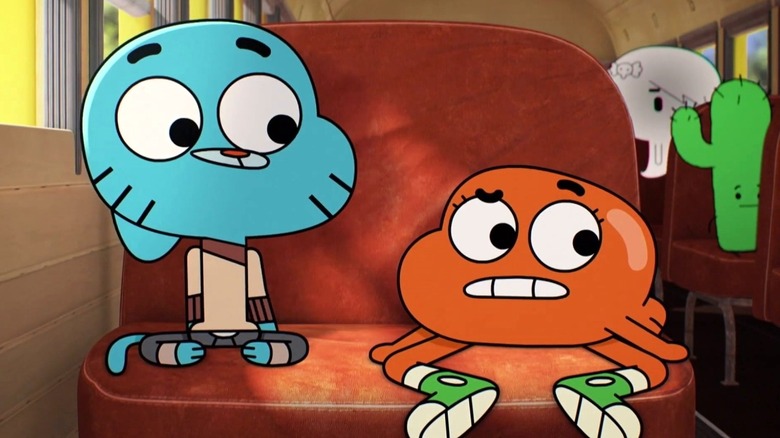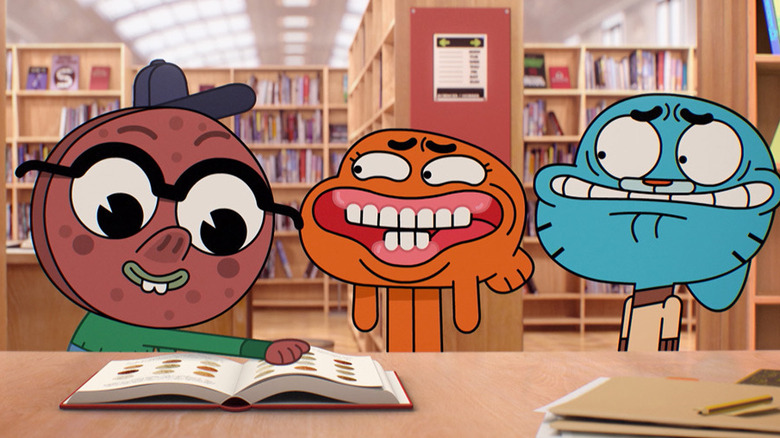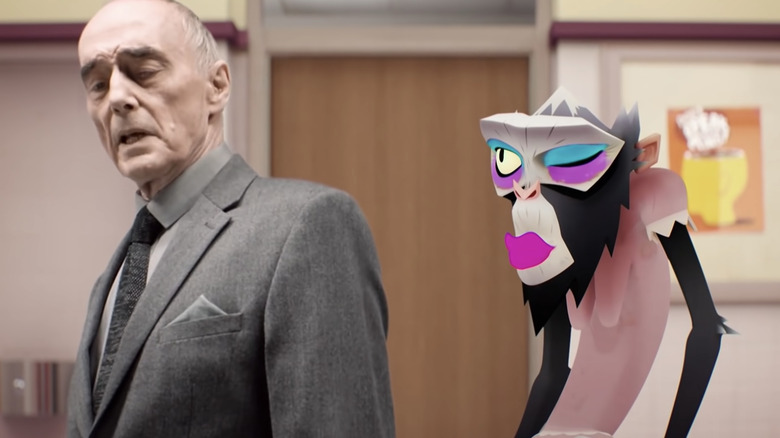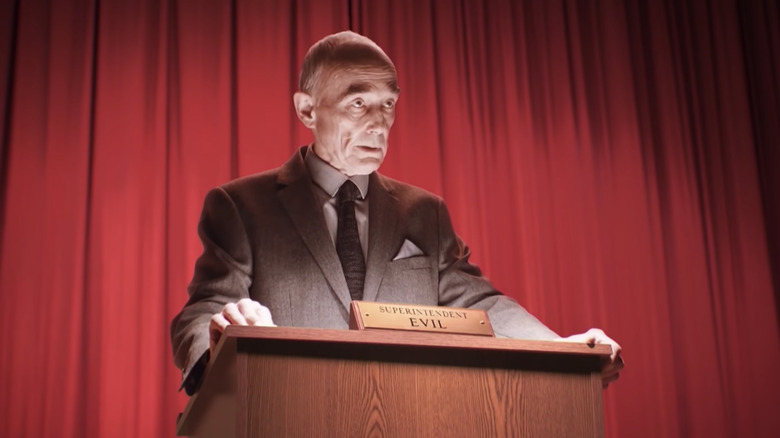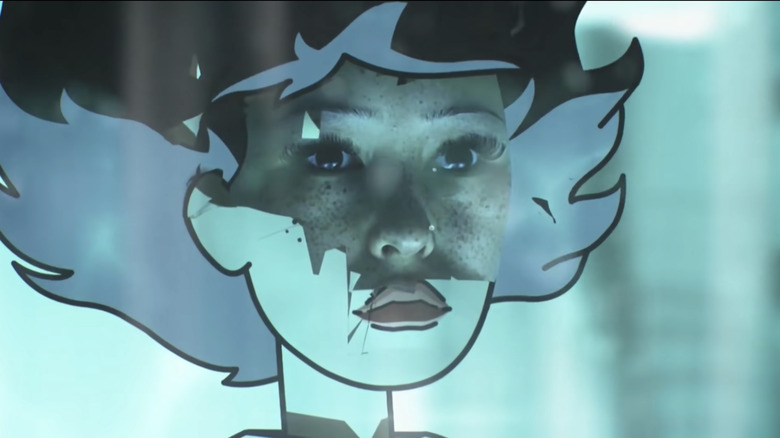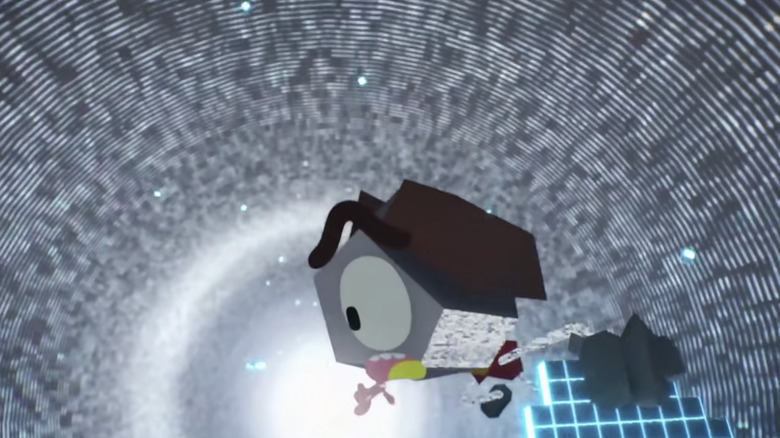How The Amazing World Of Gumball Finale Predicted The Animated Purges
How did one oddball TV-Y7 cartoon portend a fraying landscape for Western cartoons in the streaming age? What does it have to do with a CEO strategy of cleansing out a repertoire of cartoons?
"The Amazing World of Gumball" is one bizarre crossbreed on the Warner Bros. Discovery-owned Cartoon Network. When I compiled The 10 Best Children's Animated Series Of The [Last] Decade, I had zero hesitation deciding on "The Amazing World of Gumball," which ran from 2011 to 2019 on Cartoon Network for six seasons, for its visual eclecticism and comedic minefield. The brainchild of creator Ben Bocquelet, the cartoon revolves around the exploits of the 12-year-old anthropomorphic cat Gumball Watterson and his brother Darwin Watterson (an adopted sibling who originated as a pet goldfish who grew legs). Their environment of Elmore is a wonderland of different mediums. Living in real-life photo-based environments, the 2D Watterson family interact and clash with a medium-blended world: characters comprised of CGI, flash animation, puppetry, or stop-motion. It brandished an out-there aesthetic that made it a companion to its zany contemporaries like "Adventure Time" and "Regular Show."
To understand "The Amazing World of Gumball," and its WTF series finale prophetic to a CEO business decision that compromised its future, you need to appreciate its unorthodox form.
The day they shattered the fourth wall
Armed with a witty script, the cartoon encapsulated a range of meta humor. The team also infamously crafted a biting response to the China-animated "Miracle Star" knock-off in the form of an episode where the Wattersons outwit a "copycat" family.
But the cartoon reached its apotheosis in its variation of the "no money means literally no animation" act (a trope performed by "Chowder," where the main characters overspend and their world is stripped down to show the live voice actors in their voice booths). In "The Money," Gumball debated his family on whether to "sell out" to a Joyful Burger commercial to escape debt — a critique of commercialist and capitalistic impositions on art.
And then their entire house gets carted off by debt collectors. Suddenly, Gumball and his family are drained of their color. His sister's mouth flaps goes wayward. Darwin devolves into a sloppy doodle. The epiphany hits hard to Gumball: "When you don't have money, your whole world falls apart." Their photo-based neighborhood disintegrates and the details strip away into nothingness. This culminates into a race across the destabilizing landscape: a CGI character convulses, houses become gray and de-render into geometric basics, the CGI bus glitches and throttles out of control, the Wattersons' bodies dissolve into doodles on post-it notes, and their chase becomes a series of storyboards with scratch voices. The world returns to its colorful stability just as the Wattersons sign the commercial contract — while Gumball remains in his doodle form because he has refused.
South Park ... for the kids!
There's a particular quote by Gumball's mother in the 2018 episode "The Parents" during the Trump administration.
"I guess times [in the '60s] were easier then. If you're a man, and not a minority and more comfortable with the constant threat of nuclear annihilation. How things have changed, huh?"
In response, the family winces with pensive expressions.
A handful of episodes waved a funhouse mirror to topical events in U.S. and global politics. It really sunk its cartoon fangs into whatever subject matter it tackled. Its memorable lampoons happened toward and during the Trump administration: the generational gap between media illiterate adults and media literate kids (they bitterly sing "stupidity is hashtag trending" in this song), a school election that's an unsubtle satire of the 2016 election (Gumball standing in for Donald Trump and his sister for Hillary Clinton), the existential gloom around climate change, reactionary parents banning video games and books, a Donald Trump-expy mayor scheming to gentrify Elmore to move in rich white human families. Although Elmore is not set in a fictionalized United States, it is a contender for "TV-Y7 South Park" or "The Simpsons for Kids!"
Turns out, "The Amazing World of Gumball" shares foresight like "South Park" and "The Simpsons," both of their adult counterparts.
What's going on with Gumball's contemporaries?
HBO Max streaming has been in the news cycle for a series of disruptive business decisions — conducted by Warner Bros. Discovery CEO David Zaslav — as part of the Warner Bros. merger with Discovery. For starters, HBO Max removed 37 titles, predominantly animated projects, to cut the costs of licensing fees. Among the cartoons wiped out from the HBO Max streaming were "Gumball" Cartoon Network contemporaries like "OK K.O.! Let's Be Heroes," "Infinity Train," and "Summer Camp Island." Animators, such as Julia Potts of "Summer Camp Island," expressed their ire over the lack of warning. It (re)ignited a whole conversation about fairly compensating animators and ensuring their ownership of their work. In spite of concerns of cancellations, animated projects like the "Batman: Caped Crusaders" series are to be shopped to another streamer rather than be slotted onto HBO Max. Needless to say, the purge is like a rude cartoon mallet popping out of nowhere to smash the purpose of Cartoon Network as an accessible preservation of cartoons.
As for "The Amazing World of Gumball," the series ended up surviving the purge on HBO Max. However, not unlike "Batman: Caped Crusaders," its incoming Gumball-verse projects are to be shopped to another streamer. Right now, the "The Amazing World of Gumball: The Movie" and the following spin-off show "The Amazing World of Gumball: The Series" (both working titles) have to find a new home that's not HBO Max.
There's also the matter of the cliffhanger.
The Inquisition
Reflecting on the "Gumball" June 2019 finale episode "The Inquisition," it was a prophecy. The plot: All is disrupted at Elmore Junior High at the arrival of Superintendent Evil (Garrick Hagon, in full-bodied live-action) — christened with all the subtlety of Judge Doom in "Who Framed Roger Rabbit." And much like Judge Doom, he's a toon-in-disguise out to de-toon the world — though, not by dissolving them in toxic.
Evil's agenda goes hard. He flagrantly polices the student's cartoonish physiology and antics. He is displeased whenever they break the rules of nature (Darwin and Gumball stretching their arms to make a high five to the cosmos). Then Gumball and Darwin are horrified to discover humans, namely their classmates forcibly mutated into human bodies. They charge into the Superintendent's lab and discover their cloud-friend, humanized, in a vat. Her cartoon flesh sheds away to reveal live-action eyes and head. Body horror.
Gumball and Darwin inspire their humanized friends to revert to their original toon forms. Eventually, the gang unmasks the Superintendent Evil and are shocked that he's actually a toon denizen in disguise — namely, Rob, Gumball's cyclops archnemesis. Let's just say that Rob's ascension to villainy is a long story that involves him being a background character who was exiled to a Void of "mistakes."
The omen and cliffhanger
But Rob claims he intends no malice.
"Don't you understand what's going on in Elmore?" he says. "You have two choices. Live in ignorance what's gonna happen here. Or listen to what I have to say. It might just save your lives. The reason I've been trying to transform you—"
But he's whacked unconscious. When he wakes up alone on the school floor, Rob bemoans, "Transformation is the only chance they have of escaping to the other place and this world–" Any further answers from his lamentations are cut off when the floor disintegrates into a pit of static. Hanging from the tiles (literalizing a cliffhanger), he realizes that the doom has become reality. He falls into the white light. The show just ... freezes right there with the ominous jingle of the show's theme.
"The Amazing World of Gumball: The Movie" project will likely provide answers. Where did Rob get sucked into? Devoted fans can speculate that the pit is the same Void dimension — where "mistakes," like disco and an expy of the memetically disliked Clippy, were discarded by the universe — that Rob was cast into. Back in "The Void," Gumball and Darwin charged into that dimension to rescue a classmate erased out of existence (a parody of the trope where a minor or background character in a series can disappear with little to no explanation).
What is that "other place" that Rob references as an escape, potentially a sanctuary? It could very well be a human world — perhaps ours.
The body horror of live-action
Gumball's terror at witnessing a cartoon friend morph into a fleshy creature (see above picture) is tangled with the blatant meta at play in "The Inquisition": the anxiety of live-action productions consuming the space of animated programming and perhaps the "live-actionizing" trends of adapting cartoons into live-action movies or series for IP commercial profit — which produces less imaginative results in the eyes of die-hard animation fans. Disney has been and still is producing live-action remakes and re-imaginings of its animated classics, and the announcements of live-action re-imaginings of "Cowboy Bebop" and "Avatar: The Last Airbender" predicated the release of "The Inquisition."
A year after "The Inquisition" on October 2020, Tom Ascheim, the Warner Bros. president of Global Kids, Young Adults and Classics, announced a plan to feature more live-action fare under the Cartoon Network banner. (Ascheim's position has since been eliminated in May 2022 following the WarnerMedia's merger with Discovery.)
Naturally, the announcement of Cartoon Network doing more live-action was met with skepticism by fans because Cartoon Network's earlier experimentation with live-action met low ratings. From a fleeting 2009 to 2010, Cartoon Network experimented with CN Real live-action programming. I myself have a teenhood memory of finding the CN timeslot brimming with "Out of Jimmy's Head" (mainly live-action with animation incorporated) or some other forgettable live-action title, feeling disenchanted, and then consuming my supply of cartoons on Disney Channel or Nickelodeon (the very networks with the popular live-action shows that CN Real was competing with).
To the other place
"The Amazing World of Gumball" fanbase is still waiting to exactly learn what armageddon will swallow Elmore. Rob senses that the radically-shifted status quo will be unkind to the cartoon world. Against the tide of the HBO Max purges, the abrupt finale acquires an uncanny currency. It depicts the existential fear that a grand force will swallow the vibrance of a cartoon world and seek to cleanse it — perhaps in favor of something blander than Elmore.
"The Inquisition" isn't so much a prophecy as it is an acknowledgement of industry pattern that existed before. Rob wants to play by the rules of the incoming new world order to save them from becoming disposable "mistakes." He believes that forced assimilation into a proper form — fitting in with something "real" in the most literal definition — will be their salvation. Or it's the rejection void for them. But for Gumball, Darwin, and the rest, they'll much happier sticking to their colorful physics-defying-high-fiving selves. To forcibly erase that would defeat the purpose and possibilities of their designs.
But Elmore's cartoony future — the movie that's supposed to bridge into the spin-off show — does rest on finding a new home: some "other place" outside of HBO Max.
